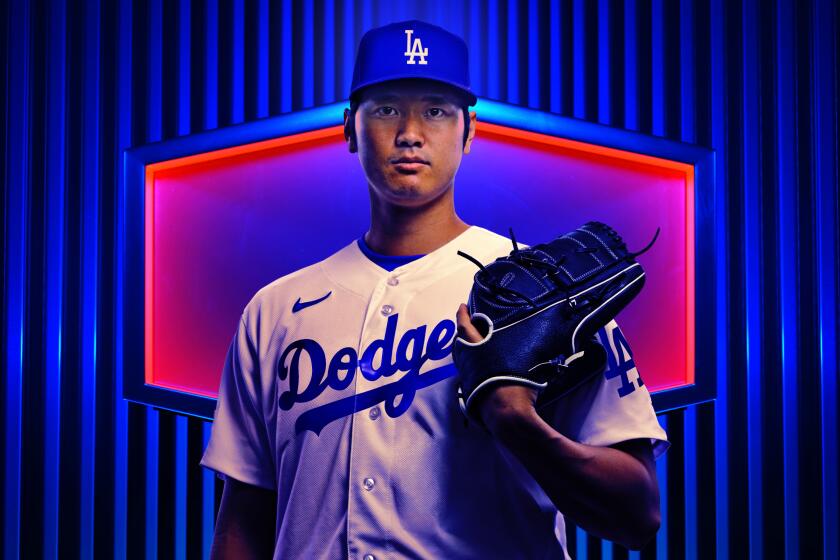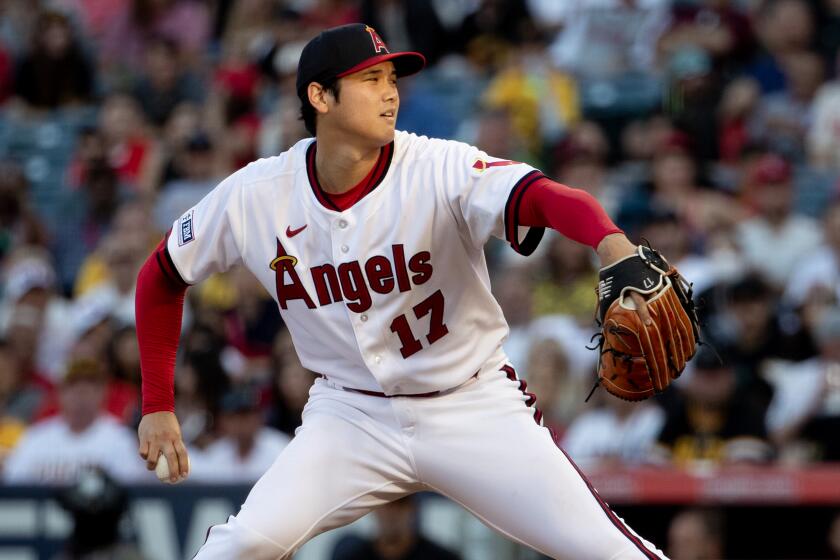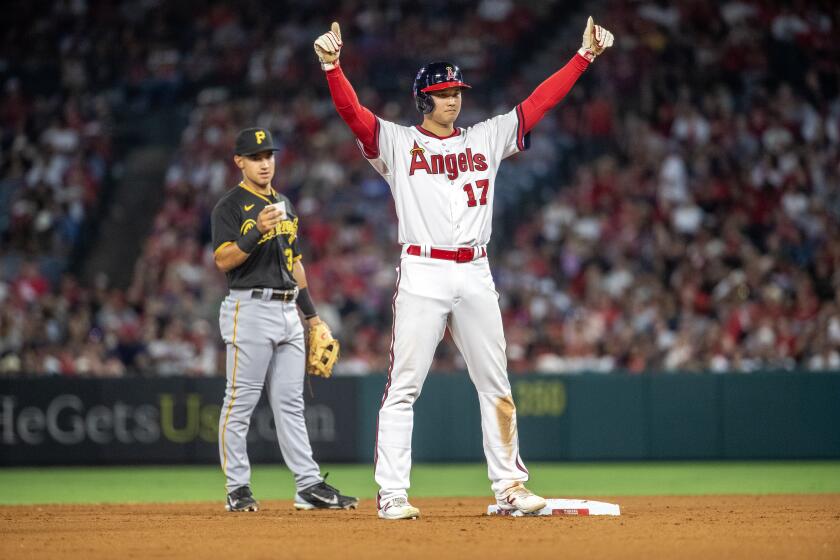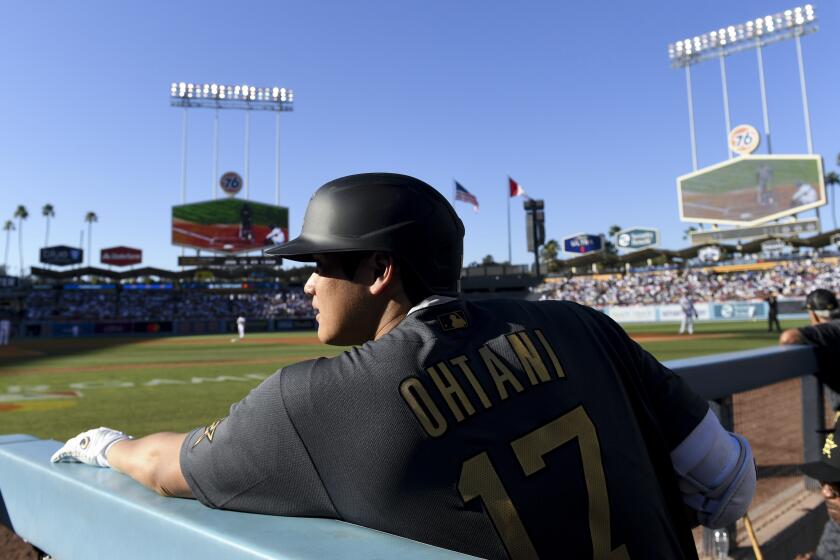
- Share via
There’s almost no such thing as a $700-million bargain in baseball.
Then again ...
By agreeing to a record-breaking 10-year, $700-million contract with Shohei Ohtani on Saturday, the Dodgers both added a two-time MVP to their star-studded roster and structured the contract — thanks largely to Ohtani’s decision to take an unprecedented amount of deferred money — in a way that should allow them to pursue more impact additions this offseason and beyond.
“The deferrals were primarily about allowing the team to be successful on the field,” said one person with knowledge of the contract who was not authorized to speak publicly about the agreement. “Because above all else, he wants to win.”
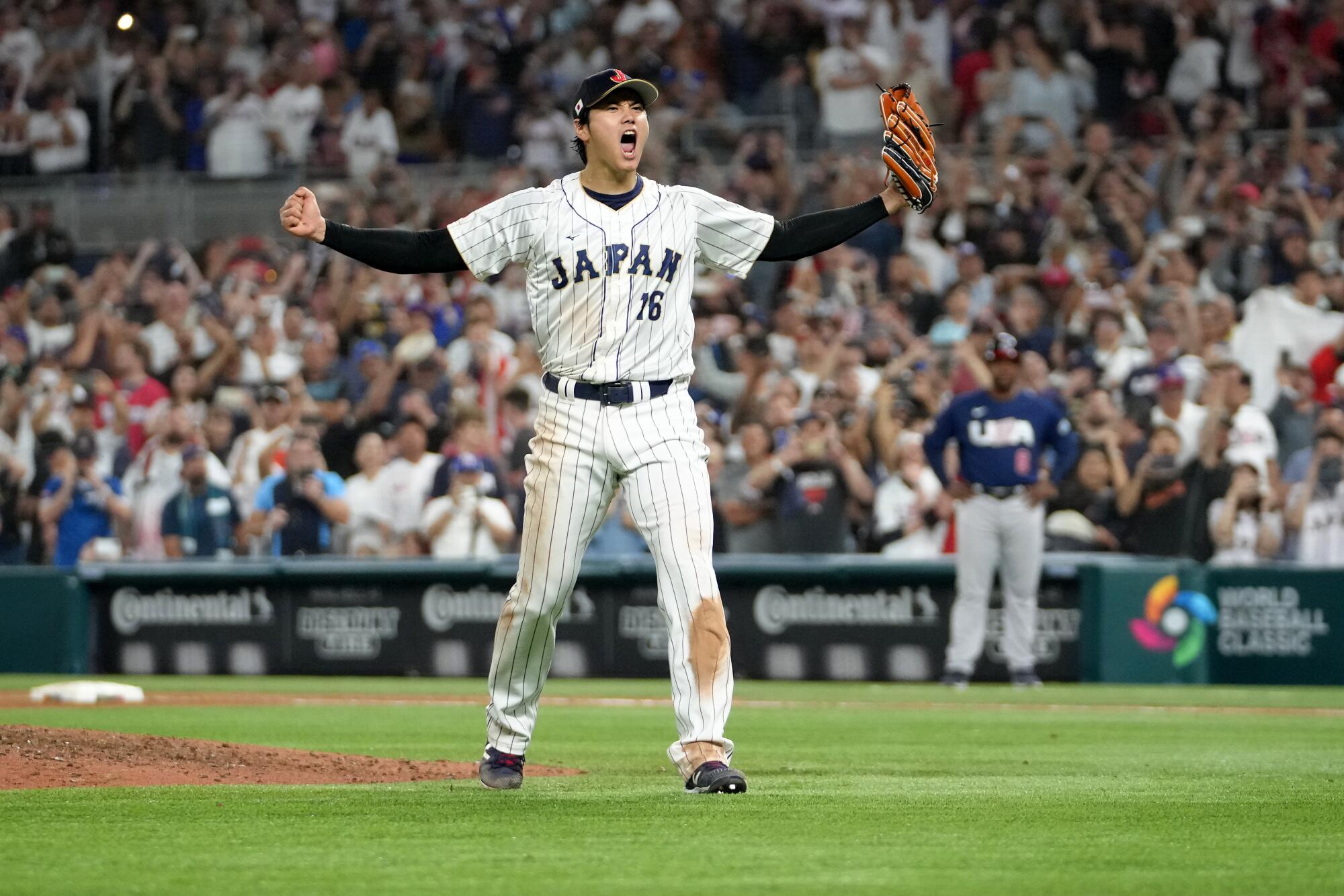
Ohtani’s deal isn’t official yet, with the Dodgers still needing to clear a spot on their 40-man roster. They could do so by cutting a player or working out a trade with another team.
Once the deal is finalized, though, it will look unlike any other in Major League Baseball history. According to the person with knowledge of its details, more than half of the guaranteed money is set to be doled out in deferred payments that will continue well past the contract’s 10 seasons.
Shohei Ohtani, who earned two-time MVP honors with the Angels, is staying in Southern California and will join the star-studded Dodgers lineup.
That’s why, even more than Ohtani’s decision to come to L.A. — which was long seen as the two-way star’s likeliest landing spot, given its status as an annual World Series contender — it was the distribution of the money in the deal that caused shock waves around the industry.
The agreement shattered Mike Trout’s previous MLB high mark of $426.5 million. It was also believed to include the most total guaranteed money of any contract in professional sports history (albeit still well short of the $100-plus million in annual salary soccer stars like Cristiano Ronaldo and Leonardo Messi have commanded overseas).
Leading up to Saturday, not even the most bullish free-agent predictions dared to forecast Ohtani’s contract starting with the numeral seven.
As The Times’ Jorge Castillo noted, one Angels front office member earlier this year openly laughed at the suggestion Ohtani could get $600 million — and that was before the 29-year-old underwent his second Tommy John surgery in September, a procedure that once threatened to potentially dampen his market in free agency.
Shohei Ohtani signing with the Dodgers gives them the perfect player at the perfect time in the team’s pursuit of another World Series title.
Alas, once the initial surprise of Saturday’s announcement wore off, and the terms of the contract came into focus, some industry experts viewed the pact as strong value — if not a subtle steal — for the Dodgers. The $700-million commitment, it is believed, won’t be nearly as cumbersome as its hefty price tag suggests.
Consider the “present-day value” of a contract. That is a calculation that determines how much a deal involving deferred payments would be worth if all of the money were paid in the present day — not in the future when inflation will decrease its overall worth.
When Freddie Freeman signed his $162-million contract with the Dodgers two years ago, for example, its $57 million of deferred money lowered the present-day value to roughly $148 million, as calculated by the MLB Players Assn. Same with Mookie Betts’ $365-million deal, which had a present-day value of only $306.7 million thanks to its $115 million in deferred payments.
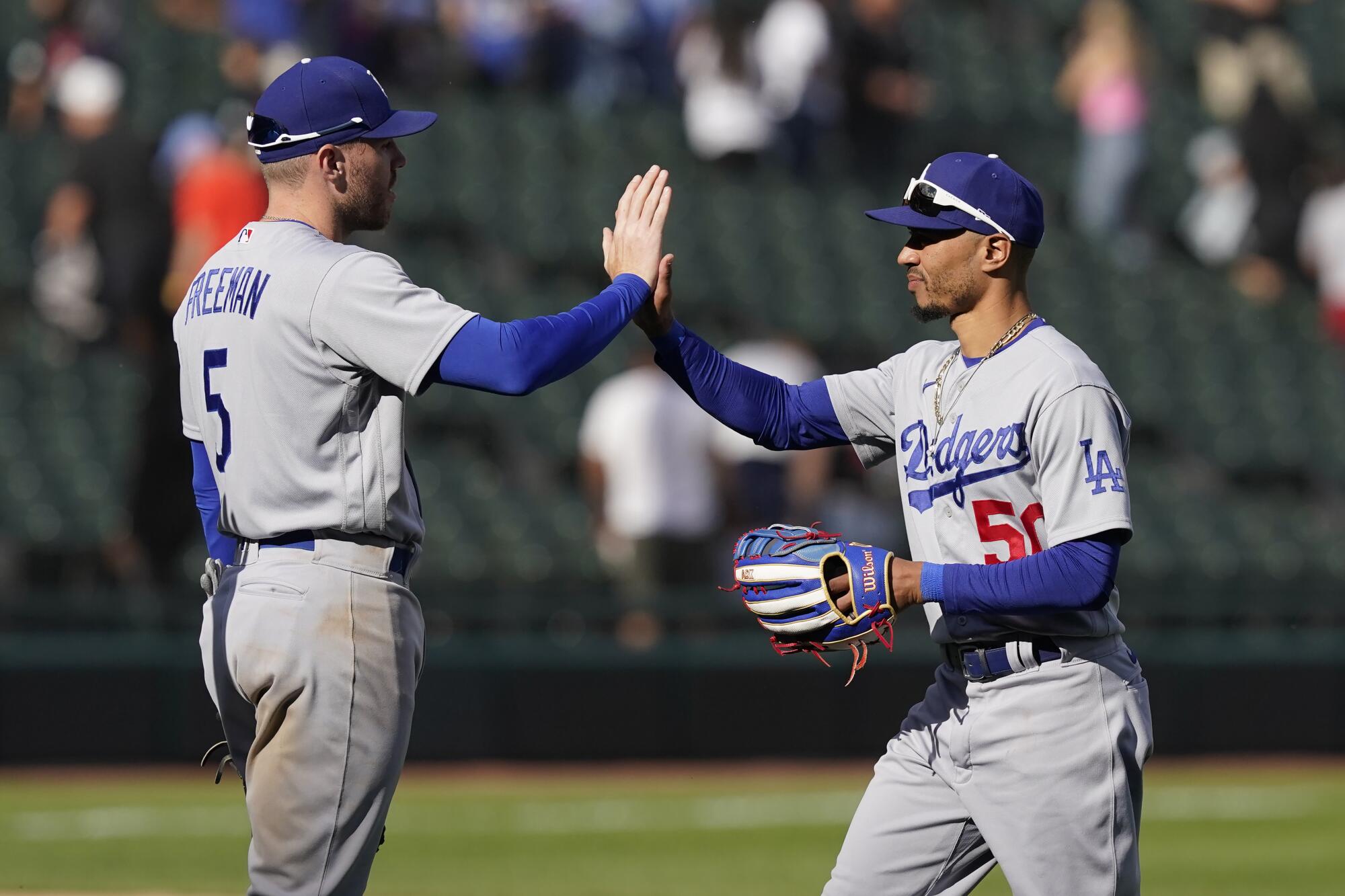
The MLBPA will calculate the present-day value of Ohtani’s contract, which was negotiated by Nez Balelo of CAA Sports, once it is finalized. But based on the public information available Saturday night, some rival agents estimated the present-day value could end up being in the $450-million to $500-million range, if not lower, depending on the length of the deferrals and interest rate used in the calculation.
That would be more in line with the levels Ohtani’s bidding was originally expected to reach.
Some agents also felt Ohtani might have essentially left money on the table by taking the Dodgers’ deferral-laden deal, possibly as much as nine figures if counting by present-day value.
That’s because, while other teams’ offers weren’t publicly known Saturday night, there was widespread belief that bidding for Ohtani could reach the $500-million to $600-million range.
In other words, given the amount of deferrals in the Dodgers’ deal, rival clubs could have presented economic packages that were in some ways on par with L.A.’s, even if they didn’t directly match the $700-million guarantee.
Maximizing salary, however, never seemed to be Ohtani’s main goal. He aimed to provide the Dodgers with the most flexibility possible for a contract on this scale. The complexities of the deal were crafted by design.
Ohtani spent the last three years languishing on mediocre Angels teams, never coming close to the postseason despite his own personal dominance and lofty team payrolls that topped $200 million.
The best player in the sport now has a much better chance to reach his goal of winning a World Series.
As a result, Ohtani’s priorities as a free agent appeared to be to A) join a winning team, and B) ensure that his mammoth contract wouldn’t create unmanageable payroll headaches that limited other roster moves his new club could make (as the Angels often faced during his tenure in Anaheim).
As officials around the league had long theorized, the money itself didn’t seem to dictate Ohtani’s decision. Winning games and creating a legacy did. And with his new Dodgers deal, the international megastar gets a little of both: the status of earning the biggest total sports contract of all time while giving the Dodgers enough payroll space to remain aggressive on the free-agent and trade markets this offseason.
Ohtani’s elbow injury means he can’t address the Dodgers’ biggest winter need, bolstering the starting rotation.
The club desperately wants a front-line ace and is targeting other established veteran pitching options.
There are plenty of free agents to pursue, from Yoshinobu Yamamoto and Blake Snell to Jordan Montgomery and Lucas Giolito. The Dodgers could also seek alternatives on the trade market, perhaps a more likely pathway with Tyler Glasnow, Dylan Cease and Corbin Burnes all possible to be moved.
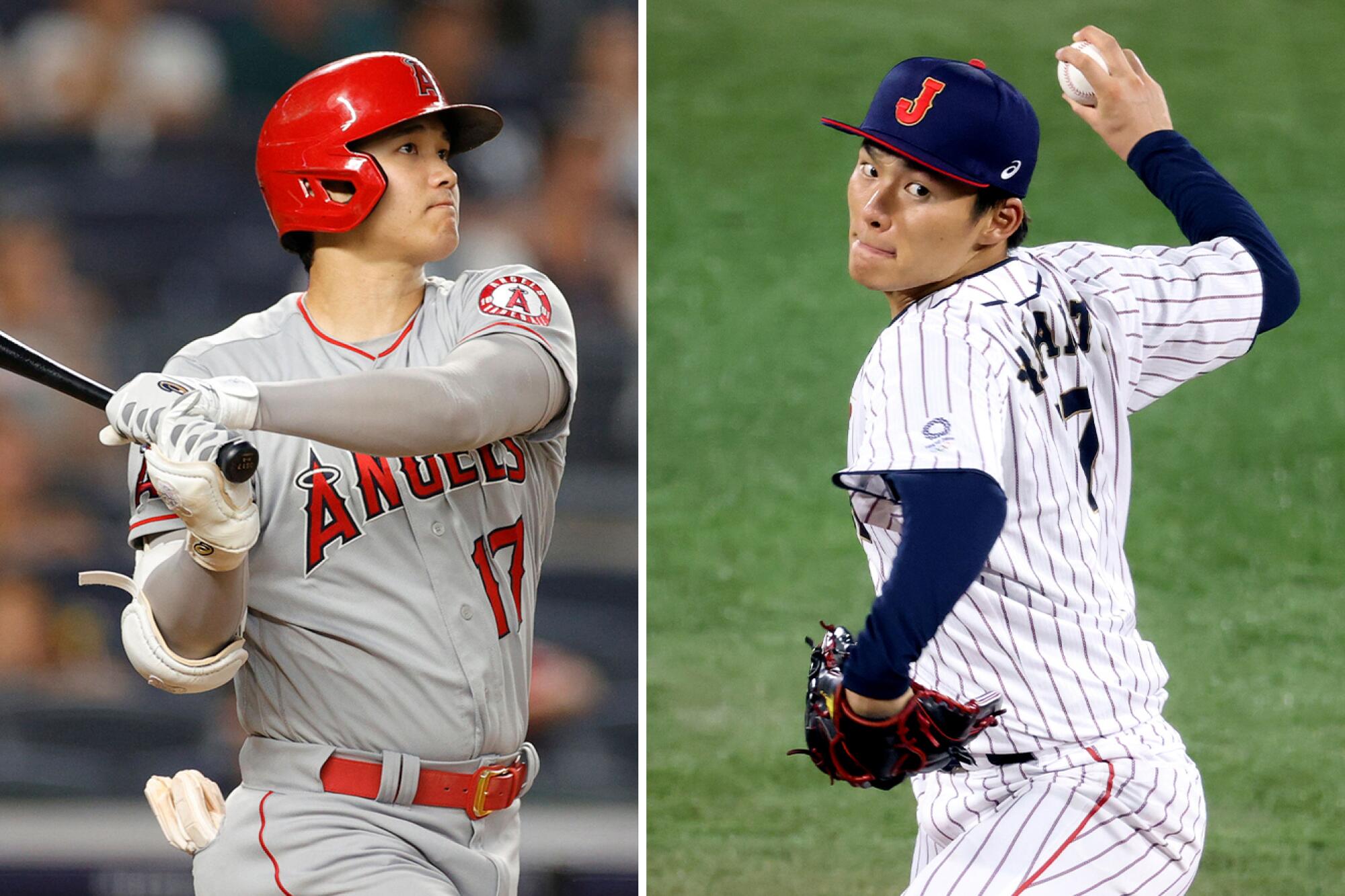
Either way, for the Dodgers to accomplish all their offseason goals, they’ll probably need to add at least a couple more high-salary players.
Ohtani’s contract structure should allow them to do it.
If Ohtani had no deferrals and made a full $70 million next year, the Dodgers’ actual payroll for 2024 would’ve risen to about $210 million, already just $12 million shy of last year’s total. Under the new deal, every dollar the Dodgers save now — and instead pay out to Ohtani in the distant future — is one the team can reallocate toward new acquisitions.
It’s almost like putting a big chunk of the guarantee on a credit card. Get the player now, and Dodgers owner Mark Walter and Co. will pay the balance off later.
The same goes for luxury tax considerations, in which payroll is calculated slightly differently based on annual average value (AAV) instead of actual year-to-year salary.
Adding Shohei Ohtani to their lineup should only help the Dodgers continue their dominance of the division, at least in the regular season.
Had no deferrals been in Ohtani’s deal, the Dodgers would already be pushing the league’s $237-million tax threshold. Once that threshold is crossed, every additional dollar the team spent would’ve been taxed at increasingly punitive rates, rising potentially as high as 110%.
However, as ESPN’s Jeff Passan reported, there is an exception in the league’s collective bargaining agreement the Dodgers seemingly seized upon. For contracts with significant deferrals, the AAV total can drop markedly. In this case, Ohtani might only count for $40 million to $50 million in luxury tax payroll, Passan reported, as opposed to the full $70 million had the deal not had deferrals.
That reduction is unlikely to keep the Dodgers completely under the tax line, which they’ve surpassed during three consecutive seasons.
But, again, every dollar that isn’t counted toward Ohtani or tax payments now is a dollar the team can spend elsewhere to bolster the roster.
There is one last factor in Ohtani’s deal that benefits the Dodgers. While even his non-deferred base salary will probably be exorbitant, the extra operating revenue the team will generate by having the Japanese star is expected to offset much (and maybe most) of those costs.
The Angels netted some $10 million to $20 million a year in revenue from Ohtani-related in-stadium and on-air advertising, promotions and marketing agreements, according to a person familiar with their finances but not authorized to speak publicly about them.
But one high-ranking MLB executive estimated that a club such as the Dodgers — with their global brand recognition, storied on-field history and league-leading average attendance of 47,371 last season — could more than double the revenue the Angels generated with Ohtani.
It’s yet another dynamic that will allow the Dodgers to recoup a chunk of Ohtani’s salary while helping him amplify his own celebrity with one of the world’s most recognizable sports teams.
Again, $700 million isn’t necessarily a bargain for Ohtani. Not when his pitching future is unclear, when he’ll turn 30 in July and when he’s still attempting his physically demanding, never-before-sustained two-way accomplishments.
Yet, thanks to the contract’s heavily deferred structure, and Ohtani’s willingness to not squeeze every last cent out of the process, the Dodgers should be capable of absorbing their new prize acquisition, and making sure he’s not the last big splash they try to make this offseason.
Times staff writer Mike DiGiovanna contributed to this report.
More to Read
Are you a true-blue fan?
Get our Dodgers Dugout newsletter for insights, news and much more.
You may occasionally receive promotional content from the Los Angeles Times.

